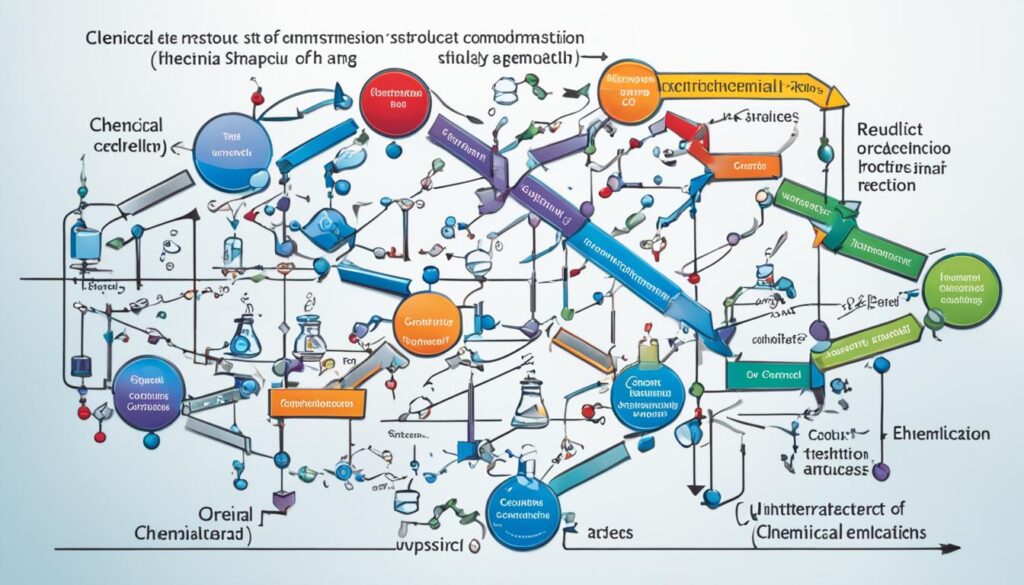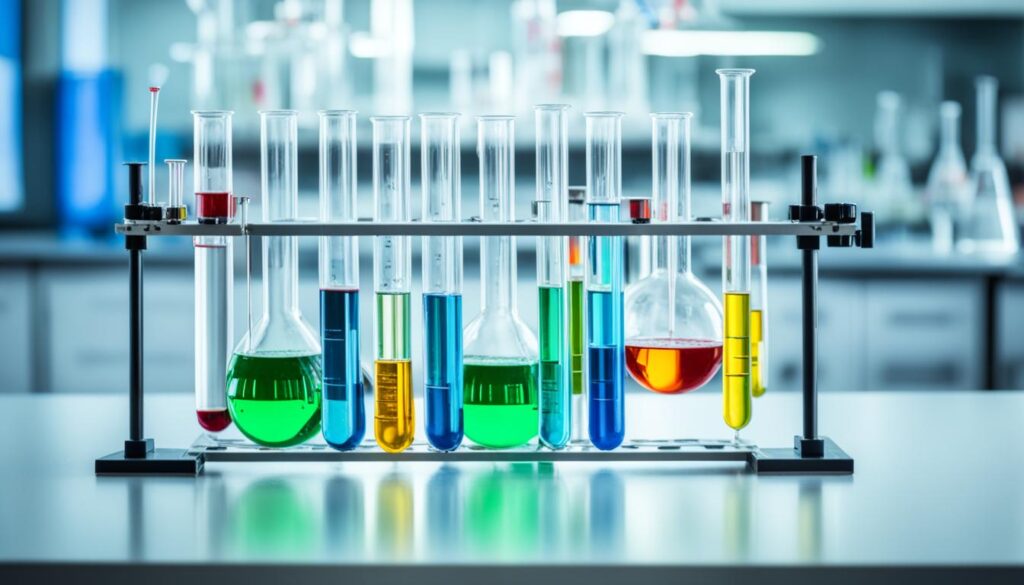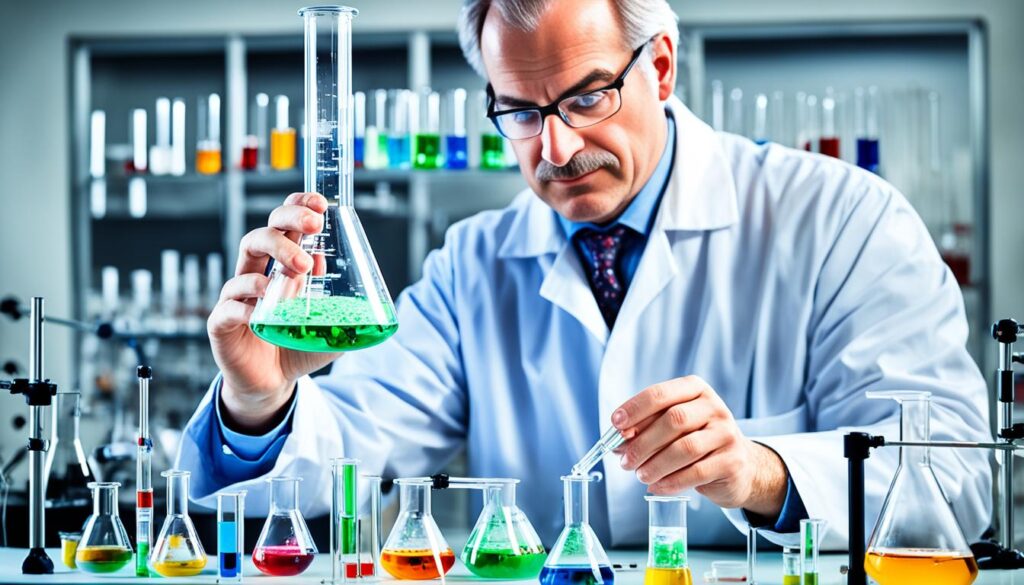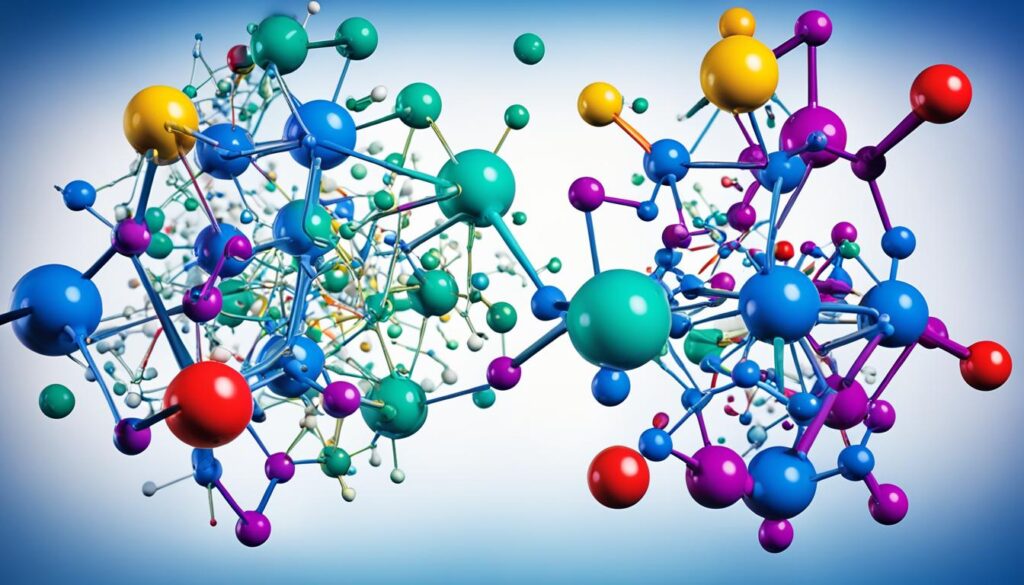In this article, we’re diving into the method of reaction analysis. This helps us highlight the chief product of a chemical reaction. By grasping organic chemistry’s basics and reviewing reaction results, we refine our product spotting and chemical making skills.
Key Takeaways:
- Reaction analysis is key to finding the main product of a chemical reaction.
- Understanding organic chemistry principles is vital for clear product detection.
- Reviewing the reaction’s result teaches us a lot about the making of chemicals.
- This process improves our power to foresee and manage chemical changes.
- Continued learning and practical work help us become masters at analyzing reactions.
Understanding Markovnikov’s Rule in Reaction Analysis
In chemistry, predicting how reactions will happen is key. Markovnikov’s rule is a big part of this. It’s key for figuring out what will happen when you add hydrogen halides to alkenes.
Markovnikov’s rule says the hydrogen goes to the carbon with more hydrogens. And the halide goes to the carbon with fewer hydrogens. This is because the carbon with more hydrogens makes a more stable carbocation.
Let’s use propene and hydrogen bromide as an example. The bromine goes to the carbon with fewer hydrogen atoms thanks to Markovnikov’s rule. This gives us 1-bromopropane as the main product.
“Adding hydrogen bromide to propene follows Markovnikov’s rule, leading to 1-bromopropane.”
This preference is all about making a stable carbocation. The carbon with more hydrogens is better because it can share the electron load. This choice leads to a stronger reaction and the main product.
Markovnikov’s rule helps predict where atoms will go in a reaction. It’s all about the stability of carbocations. This understanding deepens our grasp of how chemical changes occur.
To see Markovnikov’s rule in action, check out the image below:
Analyzing Reaction Mechanisms for Product Determination
To find the main product of a reaction, looking at the small details of how it happens is key. This shows us the steps from reactants to products well. Understanding this process helps us see how chemicals change and what affects the end result.
The middle steps and points called transition states are very important. They’re like bridges that help chemicals move from start to finish. Learning about them shows us the amazing movements of particles in a reaction.
It’s important to know how nucleophiles and electrophiles act. Nucleophiles are rich in electrons and they attack the electron-poor electrophiles. This interaction forms new bonds and breaks old ones.
Transition states are crucial points in a reaction’s journey. They can either help or block the way to making new products. Knowing about these states helps us understand and possibly choose how a reaction could go.
“In reaction analysis, it is essential to unravel the intricate dance of electrons and atoms, from intermediate species to transition states, to truly understand the factors guiding product determination.”
Understanding how bonds break and form is key to knowing a reaction’s result. Being able to control this helps us make the exact products we want. This is very useful for making chemicals with special structures and functions.

Intermediate Species and Transition States
Intermediate species may not last long, but they are very important. Studying them tells us a lot about the reaction’s process and what affects it.
Transition states are the highest-energy moments. They show us the energy needed for a reaction and its possible paths. This helps in seeing if a reaction is possible and making choices.
Nucleophiles and Electrophiles
Nucleophiles and electrophiles have unique roles in reactions. Nucleophiles donate electrons and form new bonds. Electrophiles, lacking electrons, grab them from nucleophiles.
Understanding Bond Breaking and Bond Forming
Breaking and forming bonds is key in chemical reactions. Energy is needed to break bonds, but forming them gives off energy. This study shows what pushes a reaction forward.
By studying how particles and energy move in a reaction, we get better at guessing and influencing the outcome.
Predicting Reaction Products based on Functional Groups
In organic chemistry, what happens in a reaction depends on the functional groups. Knowing reactions lets us guess the main product of the change.
Substitution reactions swap one functional group for another. Take the reaction of an alkyl halide with a nucleophile. The halide group changes to the nucleophile, making a new compound. These reactions are key in adding functional groups.
Elimination reactions strip a functional group off a molecule. In a reaction between an alkyl halide and a strong base, a hydrogen is removed. This removal of a halide group creates a double bond, making a new compound.
Addition reactions add new atoms or groups. When hydrogen bromide adds to an alkene, a hydrogen and a bromide join the alkene. A new compound with a fresh functional group forms.
Rearrangement reactions shuffle a molecule’s atoms to make a new isomer. In a pinacol rearrangement, a hydroxyl group jumps from one carbon to another. This changes the molecule into a ketone or aldehyde.
Knowing the functional groups tells us what the main product will be. This insight is key in making new stuff in both chemistry labs and drug making. It helps chemists make better and new compounds for specific uses.
Predicting Reaction Products Example
Take the reaction between bromomethane (CH3Br) and sodium hydroxide (NaOH). CH3Br’s bromine is a leaving group, while NaOH’s hydroxide is a nucleophile. In this substitution, the bromine changes to hydroxide, making methanol (CH3OH) as the main product.
Understanding the groups in the reactants lets us guess the primary product. This helps chemists change reactions well and make new compounds for specific jobs.
Factors Influencing Reaction Selectivity
Reaction selectivity is when a chemical reaction picks a certain way to make specific products. Several important things decide how a reaction will choose this path:
Steric Effects
Steric effects are about the space things take up. Big groups can block molecules from getting to each other in a reaction. In a reaction where something changes places, this block can make a big difference. It might make the reaction go a different way instead.
Electronic Effects
Electronic effects are how a molecule’s electric parts can push a reaction one way or another. A part of a molecule might like or hate electrons, changing where they go in the reaction. Because of this, the path the reaction takes can change a lot. How strong or stable these electric parts are also plays a big role in what happens next in the reaction.
Solvent Effects
The liquid around reacting molecules, or solvent, can change how reactions act. Different solvents can help or stop charges from building up. This affects how easily a reaction can happen a certain way. The solvent can make some paths harder or easier to take in a reaction.

“The selective inhibition caused by some substances seems to be due entirely to the modification of the enzymes present in the bacteria. It is possible that the changes produced are similar to those occurring altogether from steric and especially electronic effects”
Temperature Effects
The heat or cold in a reaction can sway which path it takes. This changes how stable different parts of the reaction are. So, some products become more likely than others based on the temperature. Temperature also affects how fast a reaction goes, which can alter the products made.
Catalysts
Catalysts speed up reactions but don’t get used up in the process. They can also pick a favorite in a reaction. By choosing to support certain steps in a reaction, they can guide the products that are made. This majorly tweaks which way the reaction goes, leading to different final products.
Thinking about all these variables helps us understand how reactions pick their pathways. By understanding the role of space, electric charge, the environment, temperature, and catalysts, we can steer reactions towards the outcomes we want.
Experimental Methods for Identifying Reaction Products
In our hunt for a reaction’s main product, we use many techniques. These methods give us key info about what the products are made of. Through spectroscopic and chromatographic tools, we pick out the key product and check it’s the right one.
Spectroscopic Techniques
Spectroscopic tools are very informative about reaction products. Mass spectrometry helps find the products’ weight and structure, pinpointing them. Looking at nuclear magnetic resonance (NMR), we see how atoms in the product connect. Infrared spectroscopy lets us know what parts or groups make up the products, revealing their structure.
Chromatographic Techniques
Chromatography helps break down a reaction mix to find its parts. Gas chromatography sorts out the gaseous parts and tells us their amount. This method helps us match the mix’s parts to standard references, finding the main product easily.
Using both sets of tools, we learn a lot about the main product. This understanding verifies the product’s identity and the success of the reaction.
Case Studies: Identifying Major Products in Specific Reactions
We’re diving into different reactions to better understand how to tell the main product. These real-life examples will show us how to apply what we’ve learned already. We’ll get hands-on tips for picking out the main product and analyzing results.
Case Study 1: Hydrogenation of Alkenes
Let’s look at hydrogenation, where alkenes react with hydrogen gas using a catalyst. This case involves using palladium on carbon. It’s like a game where we add hydrogen atoms to the double bond, creating a saturated alkane.
Case Study 2: Esterification Reaction
Esterification focuses on mixing a carboxylic acid and alcohol with an acid catalyst. Doing this makes an ester. We’ll see how to identify the main product in esterification reactions.

Case Study 3: Oxidation of Alcohols
Oxidizing alcohols uses agents like chromium (VI) oxide to make different products. These include aldehydes, ketones, and carboxylic acids. This exploration will teach us about the products of alcohol oxidation.
Working through these case studies will give us a solid grip on finding the major product and studying reactions. These examples show how to use our knowledge in real cases. We’ll become better at spotting main products and understanding reactions.
Advancing Your Organic Chemistry Prowess
To get better at spotting big products and understanding reactions, keep learning about organic chemistry. By diving deep into this subject, we get to know the rules that govern chemical reactions better.
Getting good textbooks is a great move. They cover a lot, from how reactions happen to changing functional groups. Textbooks by experts are gold for building your know-how.
Online courses are also super helpful. They let you learn when it’s best for you. Plus, you can focus on the stuff you find most interesting. In these courses, you can hear lectures, try hands-on exercises, and take quizzes. This all makes the concepts stick better.
Practice makes perfect in reaction analysis. Work on problems that ask you to find main products and understand reactions. These practice runs help you apply what you know. Over time, you’ll get really good at handling the tricky stuff.

Don’t forget about online resources for more practice. They often include fake tests and activities you do interactively. These can give your learning a good boost. Use the internet to find all kinds of study aids in the comfort of your home.
Joining a study group or an online forum can be a great idea. It’s a chance to talk with others who love organic chemistry. You can help each other, learn new things, and look at topics from different angles.
“Education is the passport to the future, for tomorrow belongs to those who prepare for it today.” – Malcolm X
Sticking with organic chemistry opens up many paths. You might work in research, study more, or find a job in an industry. Your skill in finding and understanding how chemicals change will be very valuable.
Keep investing in your organic chemistry studies. Look for new learning materials, do lots of practice, and try online classes. With hard work and a love for learning, you’ll reach your full potential as an organic chemist.
Conclusion
In conclusion, our journey through reaction analysis has deepened our understanding of organic chemistry. We’ve learned to use Markovnikov’s rule and study reaction mechanisms. This lets us explore the complex world of chemical changes and reach the desired results.
To understand further, we should think about many things that affect which products a reaction makes. These include how much space is around a molecule, how electronic charges move, and the impact of the environment and added substances. By considering these, we get better at predicting what will happen in a reaction.
Using tests like spectroscopy and chromatography is crucial. They help us spot the main product and prove what it is made of. These tests are key to making sure our predictions are right and boosting our knowledge.
As we keep learning and working on reaction analysis, we get better in organic chemistry. We become skilled in spotting the products of reactions and making new chemicals. With hard work and using what we know, we can do a lot in the area of reaction analysis.